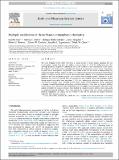Files in this item
Multiple oscillations in Neoarchaean atmospheric chemistry
Item metadata
| dc.contributor.author | Izon, Gareth | |
| dc.contributor.author | Zerkle, Aubrey Lea | |
| dc.contributor.author | Zhelezinskaia, Iadviga | |
| dc.contributor.author | Farquhar, James | |
| dc.contributor.author | Newton, Robert J. | |
| dc.contributor.author | Poulton, Simon W. | |
| dc.contributor.author | Eigenbrode, Jennifer L. | |
| dc.contributor.author | Claire, Mark | |
| dc.date.accessioned | 2015-10-15T12:10:02Z | |
| dc.date.available | 2015-10-15T12:10:02Z | |
| dc.date.issued | 2015-12-01 | |
| dc.identifier | 217533978 | |
| dc.identifier | dee8e52a-0b05-4767-881e-79157abe8b4e | |
| dc.identifier | 84944080978 | |
| dc.identifier | 000363828600026 | |
| dc.identifier.citation | Izon , G , Zerkle , A L , Zhelezinskaia , I , Farquhar , J , Newton , R J , Poulton , S W , Eigenbrode , J L & Claire , M 2015 , ' Multiple oscillations in Neoarchaean atmospheric chemistry ' , Earth and Planetary Science Letters , vol. 431 , pp. 264-273 . https://doi.org/10.1016/j.epsl.2015.09.018 | en |
| dc.identifier.issn | 0012-821X | |
| dc.identifier.other | ORCID: /0000-0001-9518-089X/work/34103240 | |
| dc.identifier.other | ORCID: /0000-0003-2324-1619/work/60427944 | |
| dc.identifier.uri | https://hdl.handle.net/10023/7654 | |
| dc.description | This study was supported financially by NERC Fellowship NE/H016805/2 (to AZ) and a NERC Standard Grant NE/J023485/2 (to AZ, MC and SP). | en |
| dc.description.abstract | The Great Oxidation Event (GOE) represents a crucial juncture in Earth history, signifying the rise in atmospheric oxygen from parts per million to per cent levels at ~2.45-2.32 billion-years-ago (Ga). Although planetary oxygenation undoubtedly led to the inception of the contemporary Earth system, the trigger(s) and mechanism(s) controlling this chemical reorganisation remain elusive. Quantitative estimates of the atmosphere's composition in the prelude to the GOE are central to understanding this oxygenation event. Previous analyses of 2.65-2.5 Ga sediments from the Griqualand Basin (South Africa) invoke a tantalising picture of an unusual Earth environment, alluding to an atmosphere periodically dominated by a layer of organic particles ("haze") formed from methane photolysis. However, as yet this hypothesis has remained untested. Here we present four new coupled carbon and quadruple sulphur isotope records from distal, time equivalent (2.7-2.5 Ga), sedimentary successions from South Africa and Western Australia. These extended records reveal similar chemostratigraphic trends, supporting a dynamic terminal-Neoarchaean atmosphere, oscillating between a hazy state at elevated methane concentrations, and a haze-free anoxic background state. We suggest these atmospheric aberrations were related to heightened biogenic methane fluxes fuelled by enhanced nutrient delivery from climatically or weathering induced feedbacks. These data question the canonical view of a simple, unidirectional planetary oxygenation and signify that the overture to the GOE was governed by complex feedbacks within the Earth-biosphere system. | |
| dc.format.extent | 1961143 | |
| dc.language.iso | eng | |
| dc.relation.ispartof | Earth and Planetary Science Letters | en |
| dc.subject | Neoarchaean | en |
| dc.subject | Multiple sulphur isotopes | en |
| dc.subject | MIF | en |
| dc.subject | Methane | en |
| dc.subject | Hydrocarbon haze | en |
| dc.subject | Atmospheric oxygen | en |
| dc.subject | GE Environmental Sciences | en |
| dc.subject | NDAS | en |
| dc.subject | BDC | en |
| dc.subject | R2C | en |
| dc.subject.lcc | GE | en |
| dc.title | Multiple oscillations in Neoarchaean atmospheric chemistry | en |
| dc.type | Journal article | en |
| dc.contributor.sponsor | NERC | en |
| dc.contributor.sponsor | NERC | en |
| dc.contributor.institution | University of St Andrews. Earth and Environmental Sciences | en |
| dc.contributor.institution | University of St Andrews. St Andrews Isotope Geochemistry | en |
| dc.identifier.doi | https://doi.org/10.1016/j.epsl.2015.09.018 | |
| dc.description.status | Peer reviewed | en |
| dc.identifier.url | https://www.sciencedirect.com/science/article/pii/S0012821X15005853#se0140 | en |
| dc.identifier.grantnumber | NE/H016805/2 | en |
| dc.identifier.grantnumber | NE/J023485/2 | en |
This item appears in the following Collection(s)
Items in the St Andrews Research Repository are protected by copyright, with all rights reserved, unless otherwise indicated.

